Author: Talia Huculak

-
 Photo Credit : tolerance.ca
Photo Credit : tolerance.ca
Victor Teboul
Francophone Canadian writer and educator Victor Teboul, Ph.D., was born in Alexandria, Egypt. A longtime resident of Montreal, his work focuses on Jewish and Quebecois identity, the Egyptian Jewish community, and his own experiences as a Jewish individual exiled from Arab lands. He is the founding editor of the Tolerance.ca webzine, which he created in 2002 to promote a critical approach to issues of tolerance and diversity. He has also been a tireless promoter of Québécois-Jewish relations.
Teboul’s family immigrated to Quebec when he was a child, after a brief stay in France. He earned his Master’s degree in literature from McGill University and a Doctorate in French Studies from Université de Montréal. He went on to teach history at Université du Québec à Montréal and Quebec literature at a French-language college near Montreal. Teboul has been a member of the non-fiction jury for Canada’s Governor General’s Literary Awards. In addition to his success as a professor and writer, he has written, hosted and produced several radio series for Radio-Canada.
Teboul is very prolific, with several books and numerous articles to his name. His semiautobiographical novel La Lente Découverte de l’étrangeté centered around the expulsion of Egypt’s Jewish community during the Suez Canal crisis in the late 1950s, and his 1985 book, Mythe et images du Juif au Québec, uncovered and explored anti-Semitic tropes prevalent in Quebec’s literary canon and history books. Bienvenue chez Monsieur B.! is another of his most popular novels. Teboul’s books and essays have been widely read, giving voice to Montreal’s Egyptian Jewish community even as they have occasionally created a stir among Quebec’s francophone intellectual elite.
In addition to his success in academic and artistic circles, Teboul has done extensive outreach between Montreal’s mostly Anglophone Jewish community and Francophone Quebecers. In 1981, he became Quebec’s Executive Director of the Canada-Israel Committee, and set up exchanges between Israeli and Quebecois political and academic leaders. He also led a writer’s delegation to Israel on an official visit.


-
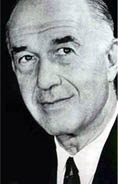 Dr. Arthur Vineberg.Photo Credit : McGill University
Dr. Arthur Vineberg.Photo Credit : McGill University
Dr. Arthur Vineberg
Dr. Arthur Vineberg, a third-generation Montrealer, was a cardiac surgeon, university lecturer and author, known for developing the “Vineberg Procedure,” a predecessor of modern coronary bypass surgery.
Vineberg received his MS and PhD in Physiology from McGill University. He studied in Paris and then New York City, where he did his internship at Bellevue Hospital. In 1933, he joined the staff of the Royal Victoria Hospital, where he worked as a heart surgeon for the next 55 years; he was also a lecturer in the Faculty of Medicine at McGill. During World War II, he served in the Canadian Army Medical Corps. He was named Head of the Department of Cardiac Surgery at the Royal Victoria Hospital in 1957.
At a time when surgeons were still largely cautious about performing heart surgery, the Vineberg Procedure involved direct implantation of the internal mammary artery into the left ventricle, providing an alternate flow of blood to offset dangerous blockages. Although the medical and surgical establishments never broadly endorsed the artery transplant operation, thousands of patients benefited from it and, years later, supporting evidence proved the procedure was successful in increasing perfusion in a diseased heart. Furthermore, the Vineberg Operation inspired many subsequent developments in the field of heart surgery, and adaptations of his method are still widely used today.
Vineberg published two books: How to Live with your Heart; the Family Guide to Heart Health (1975) and Myocardial Revascularization by Arterial/Ventricular Implants (1982). He was writing his third book, The Complete Guide to Heart Health, at the time of his death. In 1986, he was made an Officer of the Order of Canada.

-
 Emmanuel Kattan.Photo Credit : Twitter
Emmanuel Kattan.Photo Credit : Twitter
Emmanuel Kattan
Born in Montreal, Emmanuel Kattan is one of the most promising writers of the Quebec literary scene.
He holds a PhD from Université de Montréal and the prestigious title of Rhodes Scholar, which led him to pursue his postdoctoral studies at Oxford University, in Great Britain. He is the author of three critically-acclaimed novels published by Éditions Boréal, one of Quebec’s most renowned publishing houses. He has also written a remarkable essay on the Shoah entitled Penser le devoir de mémoire, published in 2002 by the Presses universitaires de France. In 2012, he published a phenomenal novel entitled Les Lignes de désir, (Éditions Boréal) whose theme explores the age-old Arab-Israeli conflict.
Previously, Kattan lived in London for almost 15 years. During this period, he worked as Director of University Affairs and Communications for the Quebec Delegation in London and as Royal Speechwriter for the office of the Commonwealth Secretary-General. Since 2010, he has been living in New York with his wife and their two children. He is presently Director of the British Council, a British government institution.
While working at the British Council in New York, he launched a project entitled “Our Shared Future.” It aimed at improving views on interculural relationships taking place on both sides of the Atlantic. Before joining the British Council, he was Head of Communications at the UN Alliance of Civilizations in New York, an ambitious project sponsored by the UN which focuses on intercultural dialogue.
Kattan is also the son of Naïm Kattan, the great Quebec author of Iraqi origin.

-
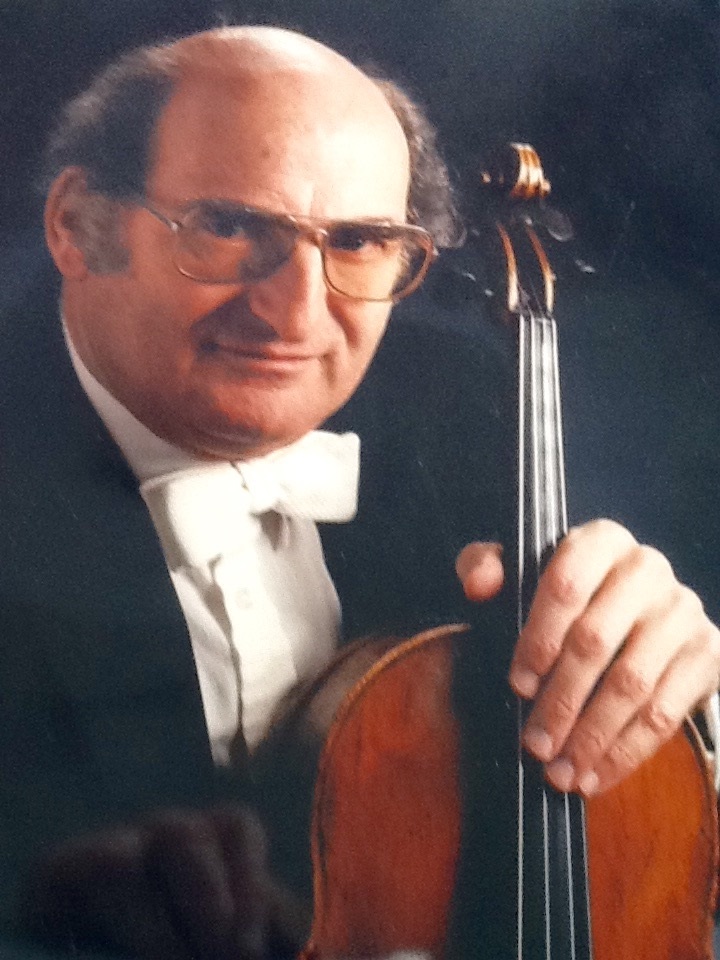 Robert Verebes.Photo Credit : Eva Verebes
Robert Verebes.Photo Credit : Eva Verebes
Robert Verebes
Robert Verebes was an award-winning Hungarian violist who was based out of Montreal for much of his life, and performed all over the world.
Born in Budapest, Verebes began violin lessons at age 7. At 15, he was accepted to the Franz Liszt Academy of Music. He initially studied violin under Desző Rados, and later took up the viola with Professor Paul Lukacs. When he was 19, Verebes became a founding member of the Bela Bartok String Quartet of Budapest. With this ensemble, he performed in several European cities, recording Bartok’s 3rd and 6th quartet in Paris in 1956.
After the Hungarian Revolution, Verebes immigrated to Canada and almost immediately received a scholarship to the Marlborough Music Festival (Vermont, USA) and an invitation to join the Ottawa Philharmonic Orchestra as first violist. During his two years in Ottawa, he founded the New Chamber Music Ensemble and performed numerous recitals and chamber music concerts.
Verebes joined the Montreal Symphony Orchestra in 1959. For the next 40 years, he was alternately second solo violist or first violist. He was well known to audiences through his solo recitals in Canada, the US, Paris, London, Oxford, Budapest, Tokyo, Shanghai, Buenos Aires and Damascus.
As a soloist, Verebes has been featured with several orchestras in Canada, the US and China. In addition to the standard solo viola repertoire, he inspired a number of composers to write for him, or dedicate their compositions to him, including Lothar Klein (“Concerto Sacro”) and Jean Coulthard (“Symphonic Ode.”) As a chamber musician, he founded and performed with several ensembles. He recorded over 100 programs for the CBC and won the prestigious Anik Award with the Classical Quartet of Montreal. He was a founding member of Musica Camerata, and the concert series Robert Verebes et ses Amis.
Verebes was a professor of viola and chamber music at the Conservatoire de Musique de Montreal for 23 years. He also taught at several summer music camps and gave master classes in Canada, the US, China and the Middle East. He has recorded 3 LPs and 8 CDs of his solo viola repertoire, and his CDs were uploaded to YouTube in 2016.
Special thanks to Eva Verebes.

-
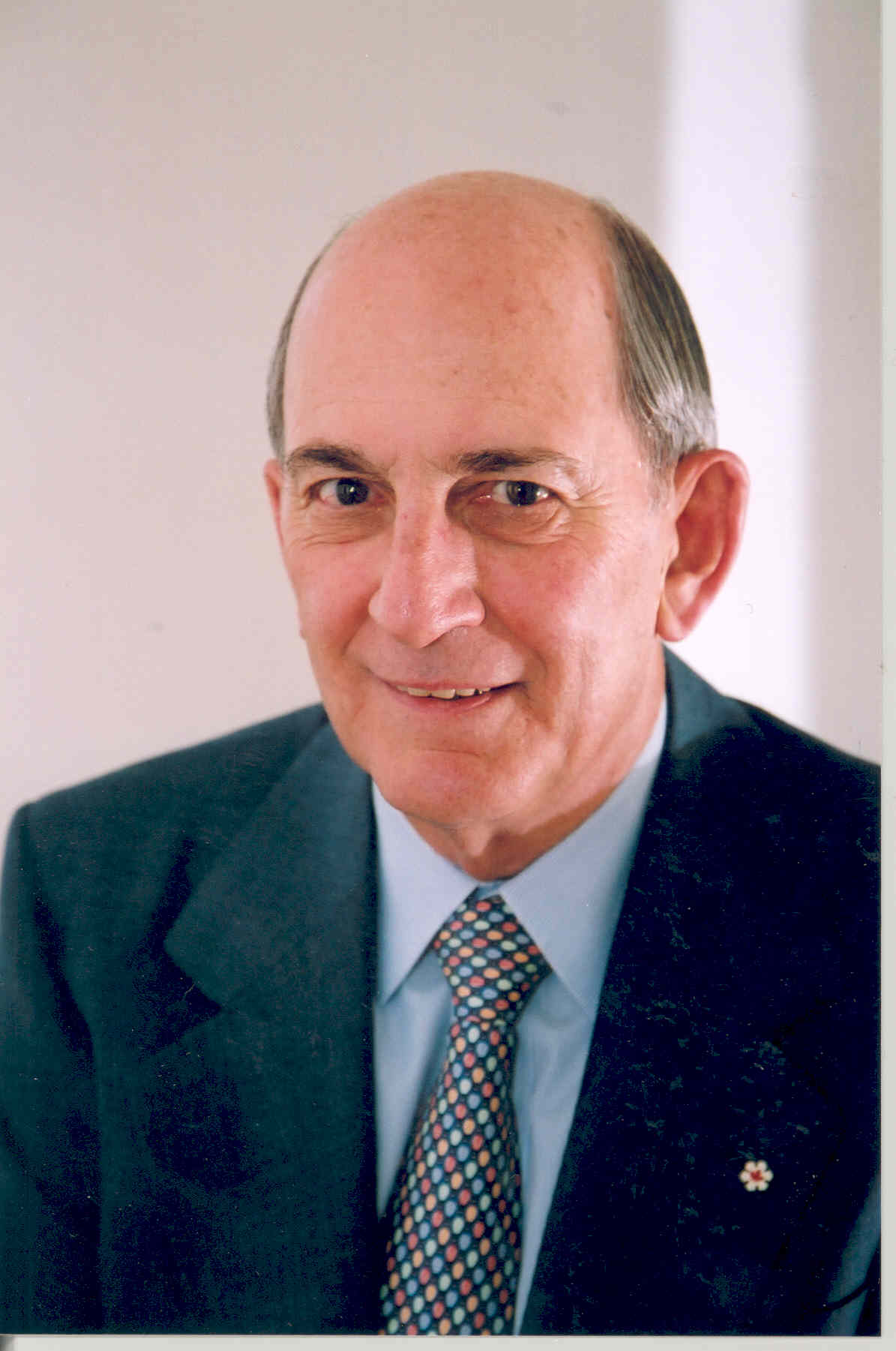
-

-
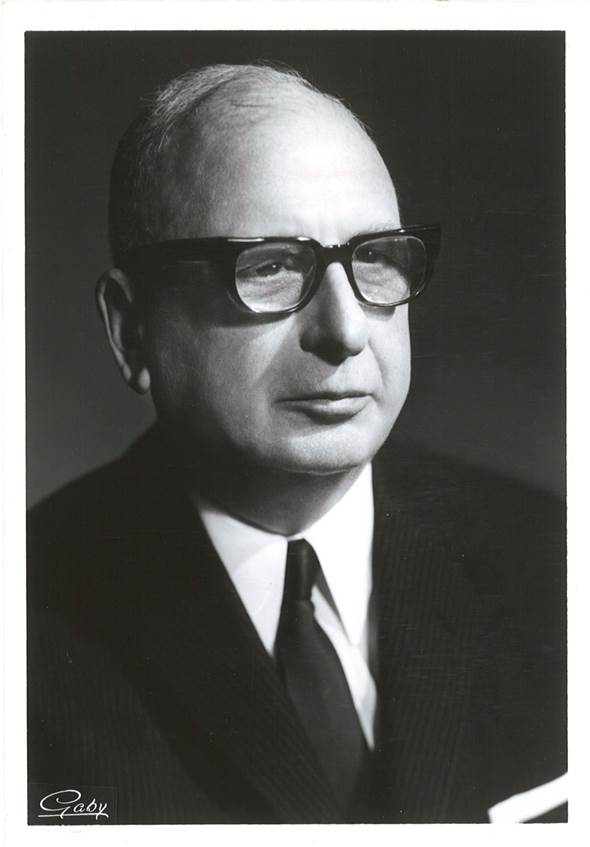 Sam Bronfman.Photo Credit : Alex Dworkin Canadian Jewish Archives
Sam Bronfman.Photo Credit : Alex Dworkin Canadian Jewish Archives -
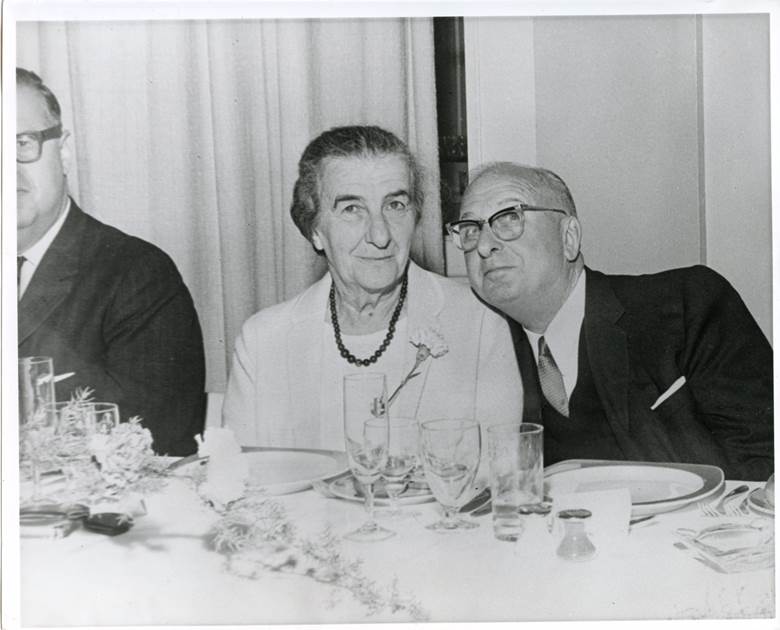 Sam Bronfman and Golda Meir.Photo Credit : Alex Dworkin Canadian Jewish Archives
Sam Bronfman and Golda Meir.Photo Credit : Alex Dworkin Canadian Jewish Archives -
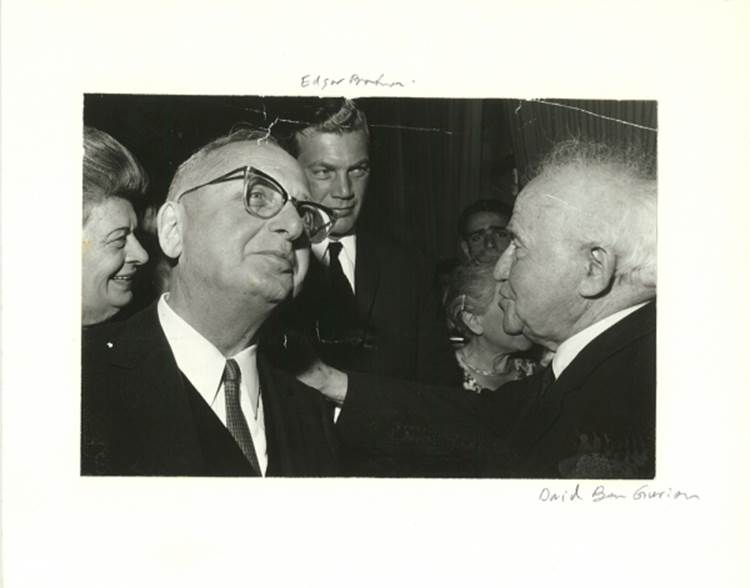 Sam Bronfman.Photo Credit : Alex Dworkin Canadian Jewish Archives
Sam Bronfman.Photo Credit : Alex Dworkin Canadian Jewish Archives -
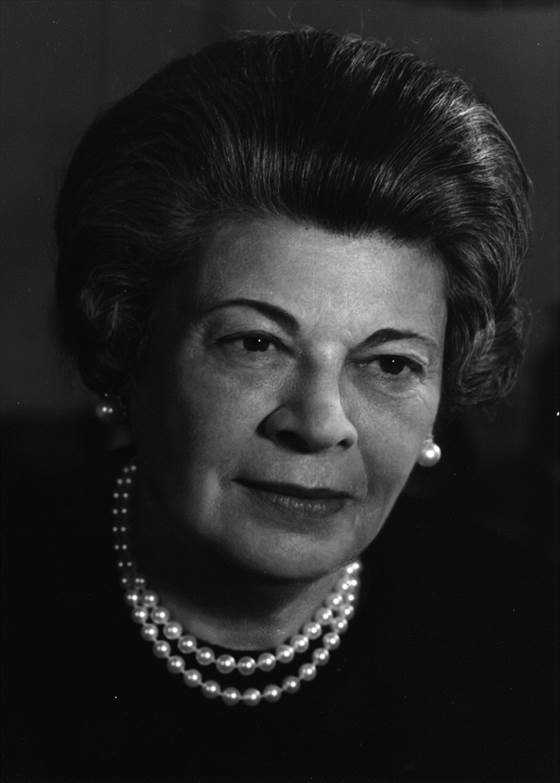 Saidye Bronfman.Photo Credit : Alex Dworkin Canadian Jewish Archives
Saidye Bronfman.Photo Credit : Alex Dworkin Canadian Jewish Archives
The Bronfmans
Coming soon

-
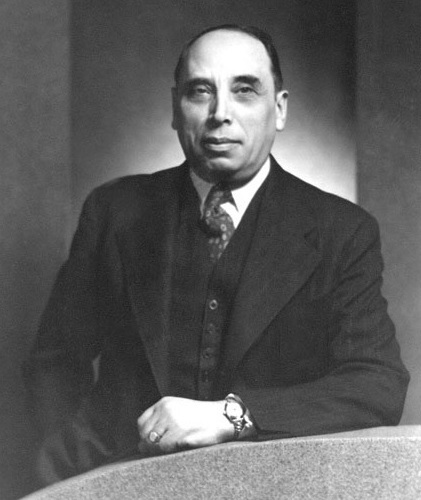 Maurice Pollack.Photo Credit : Lifeinquebec.com
Maurice Pollack.Photo Credit : Lifeinquebec.com
Maurice Pollack
Ukrainian-born philanthropist and businessman Maurice Pollack ran the department store M. Pollack Ltd. in Quebec City – one of the region’s largest and most successful companies.
Pollack was born in Kanele, Kiev. He came to Canada in 1902, speaking neither English nor French. At just 20 years old, he opened a small store on Saint-Joseph Street, which went on to have great success. This was especially noteworthy given the anti-Semitic climate of Quebec in the 1930s, in which the Catholic Church called for a boycott of Jewish stores and threatened excommunication for anyone who frequented his shop.
With his retail fortune, Pollack established a foundation in 1955. Pollack served as president until his death, at which point his son, Charles C. Pollack, took over. The Pollack Foundation has generously supported a range of Quebec institutions and organizations including McGill University, Laval University, the Quebec Symphony Orchestra, the Montreal Symphony Orchestra, the Jeffrey Hale Hospital, the Jewish Rehabilitation Hospital in Montreal and the Pollack Cultural Centre at Temple Emanu-El-Beth Sholom in Westmount, Quebec.
As part of his legacy, two Maurice Pollack Awards are given out each year – one in the “public and para-public corporations or organizations” and the other in the “private sector enterprises or organizations” category. The award recognizes individuals for their efforts regarding equal access to employment for Quebecers from cultural communities and visible minorities, as well as accommodation of ethno-cultural diversity and adaptation of services in the workplace.

-
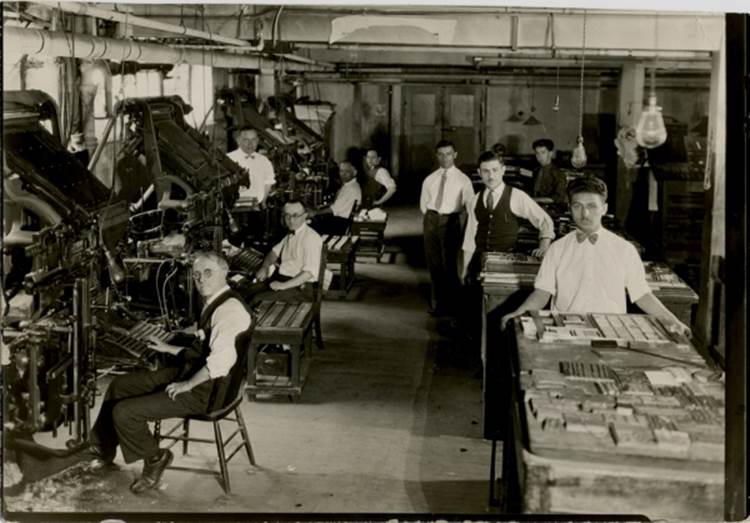 Men seated at printing machines or standing next to typesetting tables inside the Keneder adler print shop. Montreal, ca. 1930s.Photo Credit : Jewish Public Library - Archives
Men seated at printing machines or standing next to typesetting tables inside the Keneder adler print shop. Montreal, ca. 1930s.Photo Credit : Jewish Public Library - Archives -
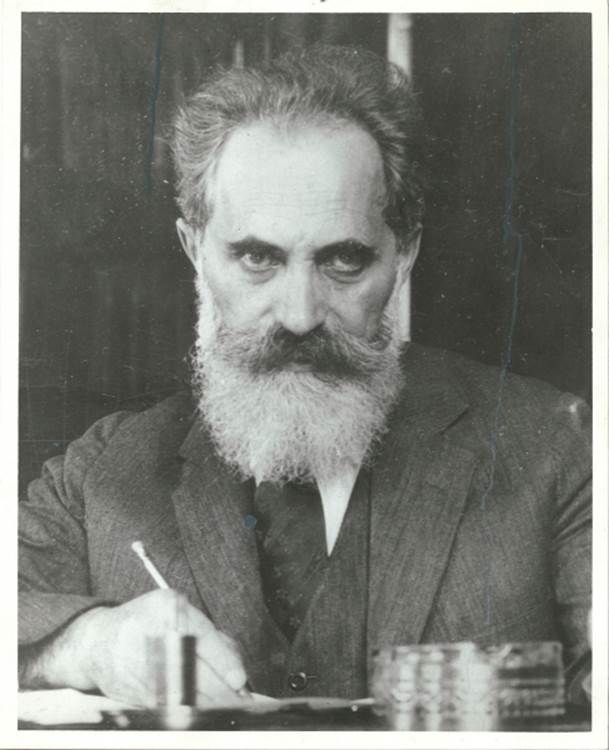 Reuben Brainin, ca. 1900s.Photo Credit : Jewish Public Library - Archives
Reuben Brainin, ca. 1900s.Photo Credit : Jewish Public Library - Archives -
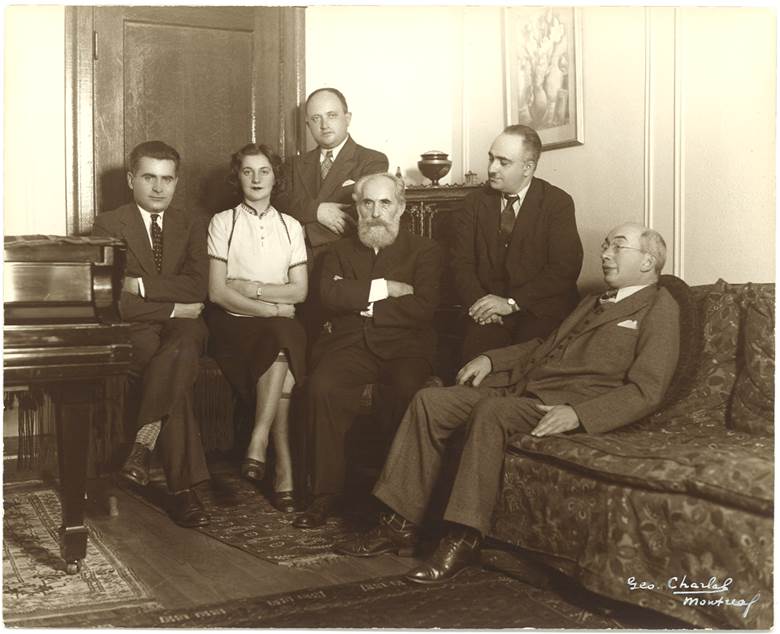 Reuben Brainin on a visit to Montreal, 1930s, together with local authors. Left to right: Israel Rabinovitch, Dora Rosenfeld (Brainin's secretary), Israel Medres, Brainin, Mordechai Ginsburg, B.G. Sack.Photo Credit : Jewish Public Library - Archives
Reuben Brainin on a visit to Montreal, 1930s, together with local authors. Left to right: Israel Rabinovitch, Dora Rosenfeld (Brainin's secretary), Israel Medres, Brainin, Mordechai Ginsburg, B.G. Sack.Photo Credit : Jewish Public Library - Archives -
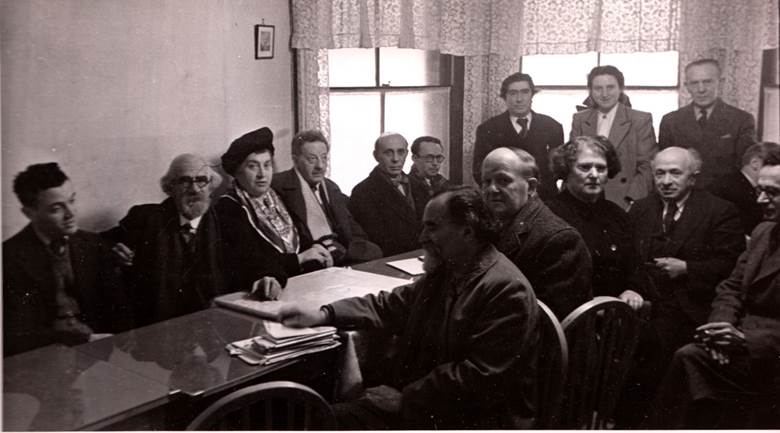 Chava, standing in back, giving a reading in London, March 1949.Photo Credit : http://chavarosenfarb.com/photos
Chava, standing in back, giving a reading in London, March 1949.Photo Credit : http://chavarosenfarb.com/photos -
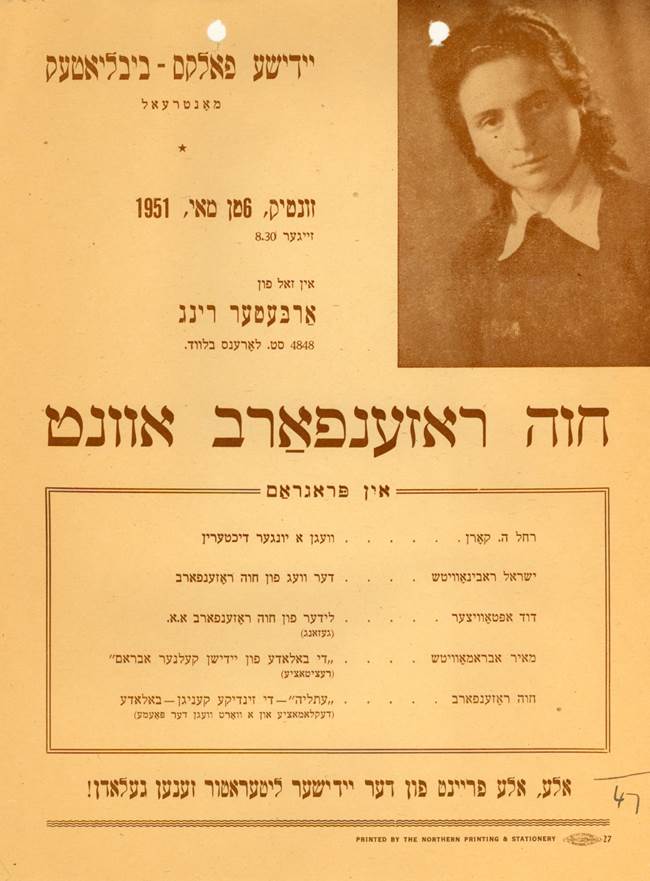 Yiddish poster for Chava Rosenfarb’s poetry from 1951.Photo Credit : Alex Dworkin Canadian Jewish Archives
Yiddish poster for Chava Rosenfarb’s poetry from 1951.Photo Credit : Alex Dworkin Canadian Jewish Archives -
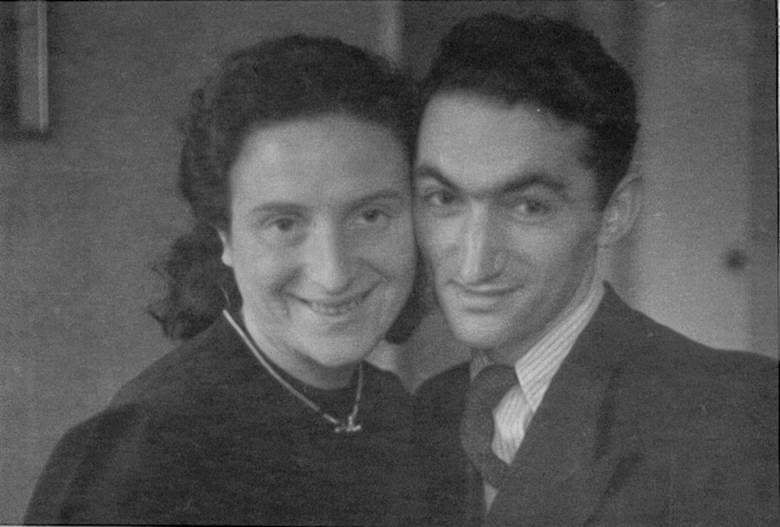 Chava and Henry Morgentaler her husband –n.d.Photo Credit : http://chavarosenfarb.com/photos
Chava and Henry Morgentaler her husband –n.d.Photo Credit : http://chavarosenfarb.com/photos -
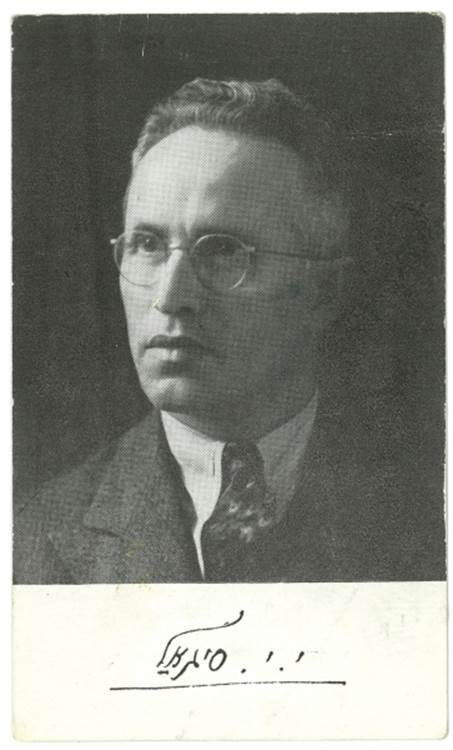 Pamphlet, with portrait of J. I. Segal, advertising an event for J.I. Segal and the publication of his book Lider Un Loybn, at the Folkshule on 5210 Waverly, ca. 1944.Photo Credit : Jewish Public Library - Archives
Pamphlet, with portrait of J. I. Segal, advertising an event for J.I. Segal and the publication of his book Lider Un Loybn, at the Folkshule on 5210 Waverly, ca. 1944.Photo Credit : Jewish Public Library - Archives -
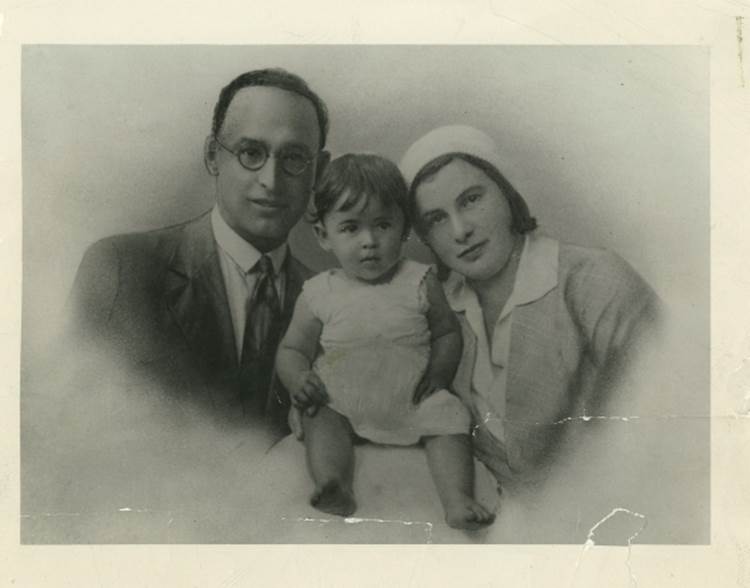 J. I. Segal, his wife Elke Rosen, and their daughter, ca. 1930s.Photo Credit : Jewish Public Library - Archives
J. I. Segal, his wife Elke Rosen, and their daughter, ca. 1930s.Photo Credit : Jewish Public Library - Archives -
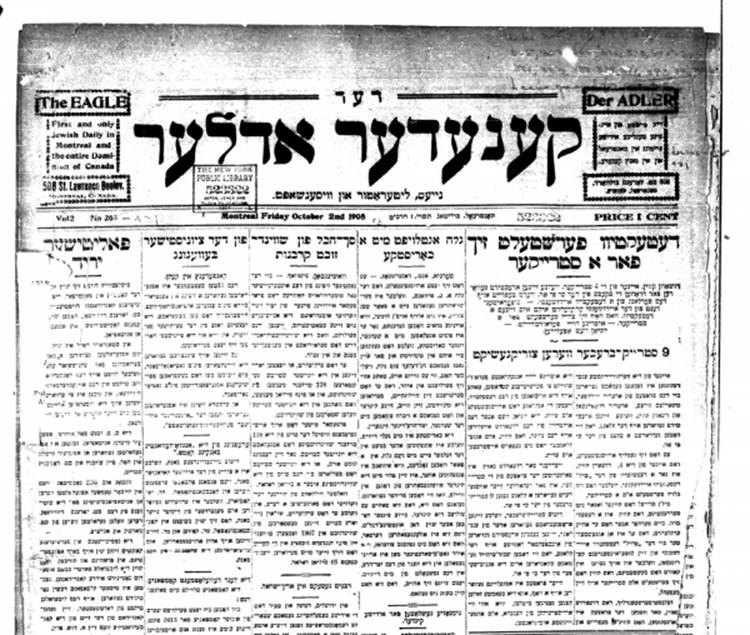 Front page of the first issue of the Keneder adler, 1908.Photo Credit : Jewish Public Library - Archives
Front page of the first issue of the Keneder adler, 1908.Photo Credit : Jewish Public Library - Archives
Yiddish Writers
Beginning in 1900, a significant number of Eastern European Jews immigrated to Canada, establishing themselves in Montreal. Coming from the Tsarist Empire, these newcomers brought their centuries-old Ashkenazi culture along with them. This produced, among other things, lots of high quality Yiddish literature in Montreal.
Several scholars from this wave of Jewish immigration went on to produce a Yiddish language cultural current in Quebec second in North America only to the one that flourished in New York. This fact is not very well known outside the Jewish community, however, because few French studies and translations conveyed the significance of the Montreal Jewish community’s cultural influence.
The Montreal Yiddish literary movement began in 1907 when a Polish immigrant, Hirsch Wolofsky, started publishing his daily Yiddish newspaper, Keneder adler (Canadian eagle), from his shop on Saint Laurent Boulevard. At this point, the Montreal Jewish population was large enough for the project to be financially viable. Recognizing the popularity of his Yiddish publication within the Jewish community, Wolofsky reached out to the Eastern European intellectual Reuben Brainin to manage his newspaper. Brainin came to Montreal in 1912. Within a few years of his arrival, he had galvanized the Yiddish cultural community, mainly by supporting the creation of schools and, in 1914, a Jewish public library – which would have a significant impact on the community over the following decades.
Yiddish literature started to take off in Montreal when the young garment factory worker Jacob-Isaac Segal published a book of poetry, Fun mayn velt (From my world), in 1918. Ahead of its time for Yiddish literature, it had a very contemporary style, a theme of openness to the world and the desire to lyrically describe Montreal’s urban environment. Others, such as Sholem Shtern, Yudica and Ida Maze, would express themselves during the interwar period, as well. After the war, Holocaust survivors arrived in Montreal and added to the literary progress that had already been made. One such author was Chava Rosenfarb, who published a poetry collection in 1948 called Di balade fun nekhtikn vald (The ballad of yesterday’s forest). Rosenfarb also wrote a very moving three-volume work about life in the Nazi concentration camps. It was published in Tel Aviv in 1972 under the title Der boym fun lebn (The tree of life).

-
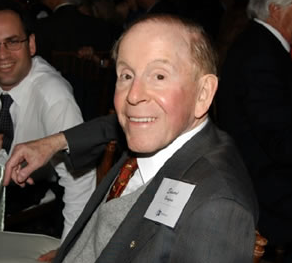 Edward Bronfman.Photo Credit : http://icehockey.wikia.com/
Edward Bronfman.Photo Credit : http://icehockey.wikia.com/ -
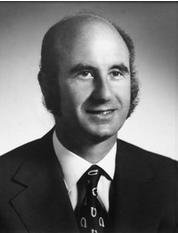 Peter Bronfman.Photo Credit : http://icehockey.wikia.com/
Peter Bronfman.Photo Credit : http://icehockey.wikia.com/
Edward and Peter Bronfman
Edward and Peter Bronfman achieved enormous success in the business world and were deeply committed to philanthropy.
Upon selling their stake in Seagram in the late 1950s, they used their capital to found Edper Investments, eventually becoming Brascan. Together, the Bronfman brothers built it into one of Canada’s lowest-key, but most powerful, conglomerates in a variety of sectors including banking, real estate, breweries, insurance and professional sports. By the early 80s, their portfolio of interests was estimated to be worth as much as $80 billion.
In addition to a vast real estate portfolio, they held major positions in blue chip companies like Labatt Breweries, London Life, Royal LePage, Bramalea, MacMillan Bloedel and, of course, the storied Montreal Canadiens Hockey Club (from 1971 to 1978).With owners Edward and Peter, Sam Pollock as the wizard-like GM, plus Scotty Bowman behind the bench, the Habs won multiple Stanley Cups and built a dynasty that showcased such legendary players as Yvan Cournoyer, Guy Lafleur, Ken Dryden, Serge Savard, Bob Gainey and Larry Robinson. If you were a hockey fan growing up in the 70s, you expected the Habs to win the Cup year after year, which they did more than any other NHL franchise.
Edward and Peter were also deeply committed to philanthropy and showed great support for the Canadian Council of Christians and Jews, The United Way, Combined Jewish Appeal, plus countless hospitals and universities. They both received the Order of Canada for their outstanding contributions to social causes.
Today, Edward’s son Brian helms the Brian Bronfman Family Foundation in Montreal, dedicated to supporting creative initiatives that have a concrete impact on the lives of individuals and their communities. The Foundation supports a host of endeavors including Centre de resources sur la non-violence, Institut Pacifique, ENSEMBLE for the respect of diversity, Zone de paix, TMCA Peace Medal Awards, Aime comme Montreal and many others.

-
 Steinberg's grocery store.Photo Credit : Steinberg Museum
Steinberg's grocery store.Photo Credit : Steinberg Museum -
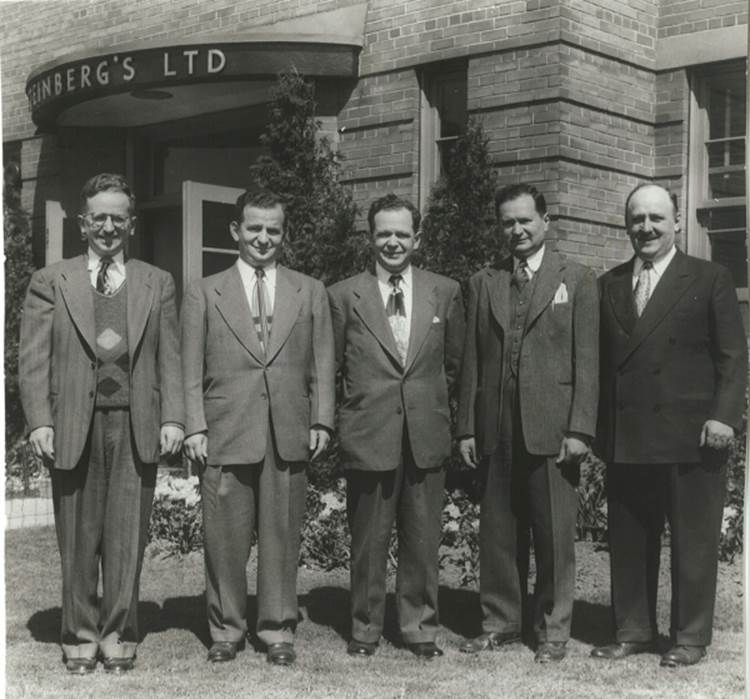 The Steinberg family.Photo Credit : Jewish Public Library - Archives
The Steinberg family.Photo Credit : Jewish Public Library - Archives
Samuel Steinberg
Coming soon

